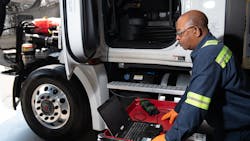Lighting the way to successful roadside inspections
Editor's note: International Roadcheck is May 4-6. This is part two of a three-part series on how fleets can prepare for and pass roadside inspections —not just during the 72-hour International Roadcheck but all year. Read part one and part three.
Gino Fontana, a vice president of operations for Transervice’s Berkeley Division, keeps track of various regional and national safety blitzes as part of his fleet maintenance program. “If Brake Safety Week is coming up, for example, we send notes to our shops in advance so that every piece of equipment that comes in — no matter what — they put an eye on the brakes, the brake lines, those types of things,” he said.
In 2020, lighting was the most common vehicle violations, comprising 12% of roadside violations, according to the Federal Motor Carrier Safety Administration. Cory Adams, vice president of engineering for Peterson Manufacturing, told FleetOwner that many lighting issues could be addressed during post-trip inspections.
The Commercial Vehicle Safety Alliance’s (CVSA) International Roadcheck is May 4-6 this year. During that 72-hour period this week, commercial motor vehicle inspectors in jurisdictions throughout Canada, Mexico and the U.S. will conduct inspections on commercial motor vehicles and drivers.
A good first step, Adams said, is for drivers and technicians to make sure light lenses are clean. “They may be functional, but if they are dirty, they may appear to be malfunctioning to an inspector,” he said.
Checking for cracks and other damages to light lenses is another way to stave off lighting failures as cracked lenses can be an “entry point for moisture, which will eventually corrode the inside of your light and cause it to fail,” Adams added.
Sometimes during the day, it can be challenging to check reflectors on trucks and trailers — and can be worth reviewing at night, Adams noted. “Try to have a co-worker watch your vehicle as you drive around the parking lot; moving vehicles can have flickering lights due to loose or poor connections that you’ll never see when your truck and trailer as sitting still.”
Adams stressed the importance of post-trip inspections. “LEDs have circuit boards and if they get damaged, they can overheat,” he said. “Feel your lights at the end of your drive to see if there’s excessive heat. That’s a warning sign you won’t be able to find when you start your shift.”
Checking all the lights on a Class 8 tractor attached to a 53-ft. trailer can take time. A driver who wants to check that all the turn signals are working, for example, has to turn one on, walk to the back of the trailer and check that it’s flashing. Then, the driver has to go back into the cab and turn on the other turn signal and walk around to check it at the rear of the trailer.
“Let’s be honest. Does every driver do that?” Fontana asked rhetorically. “A lot of drivers will pop the hazards on, assuming that if the hazards are making everything blink, then the left and right signals work.”
Transervice uses a trailer tester that can quickly troubleshoot any lighting, air brake, and ABS systems issues.
“You hook it up to a trailer, and it takes you through a sequence,” Fontana explained. “You can stand there and it gives you five seconds of the left signal, five seconds of the right signal, five seconds of the brake lights, five seconds of the running lights, and pops the ABS light. We use technology to simulate what’s going to happen when a driver is on the road to make sure all the lights are working before the truck leaves.”
If drivers aren’t taking the time to check the lights on their trucks and trailers, they can pay for it at a weigh station or other inspection points, according to Michael Oliver, vice president of operations at Velocity Truck Rental & Leasing. “Chances are, [the light] was probably out at the beginning of the day or at the end of the previous day,” he said.
Oliver also stressed that truck drivers have shifted “from drivers to operators,” controlling high-tech equipment. “Now, more than ever, it’s really imperative that the people operating the equipment fully understand it and read the vehicle owner’s manual,” he told FleetOwner. “It’s hundreds and hundreds of pages — and it’s a lot to absorb — but in order to fully maximize the equipment, you have to understand it.”
This is part two of a three-part series on how fleets can prepare for roadside inspections. Part three will look at how drivers and fleets should prepare for officer interactions on the road. Read part one and part three.About the Author
Josh Fisher
Editor-in-Chief
Editor-in-Chief Josh Fisher has been with FleetOwner since 2017. He covers everything from modern fleet management to operational efficiency, artificial intelligence, autonomous trucking, alternative fuels and powertrains, regulations, and emerging transportation technology. Based in Maryland, he writes the Lane Shift Ahead column about the changing North American transportation landscape.

